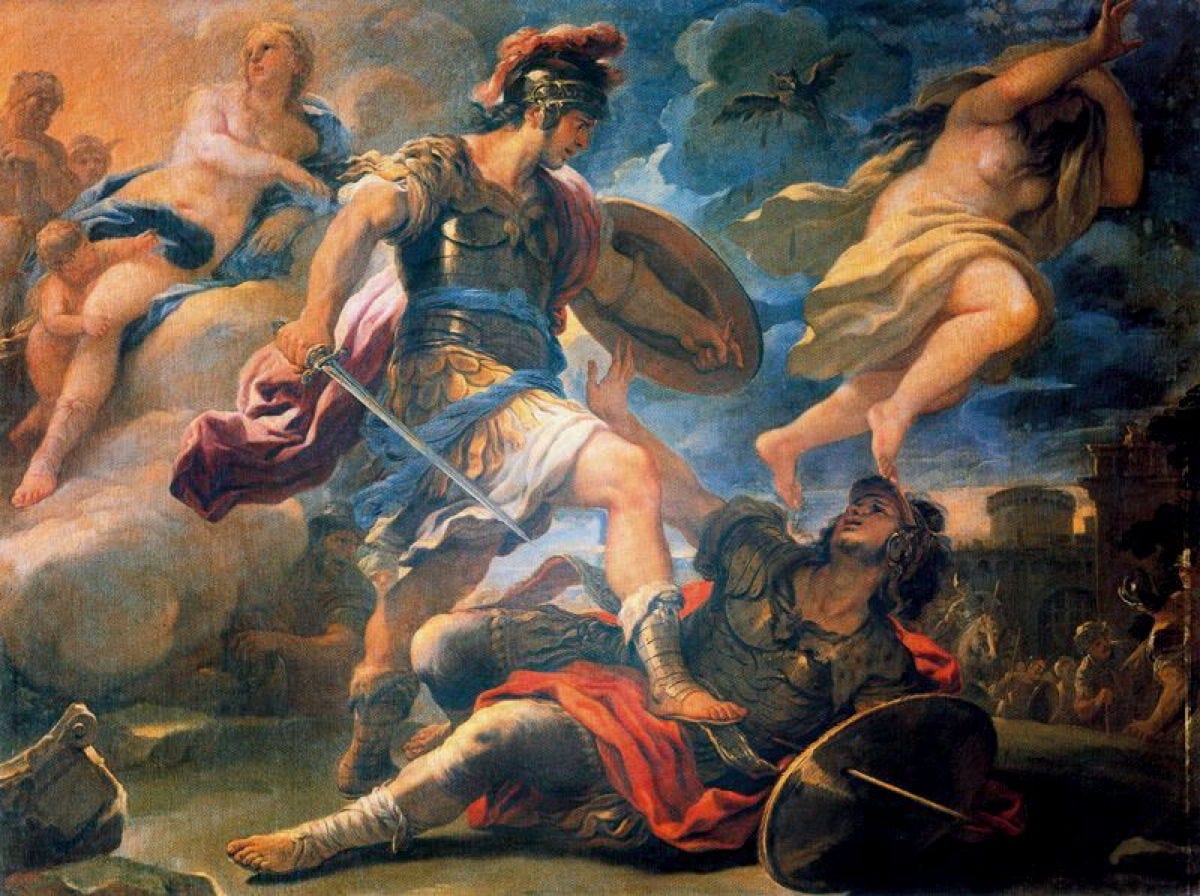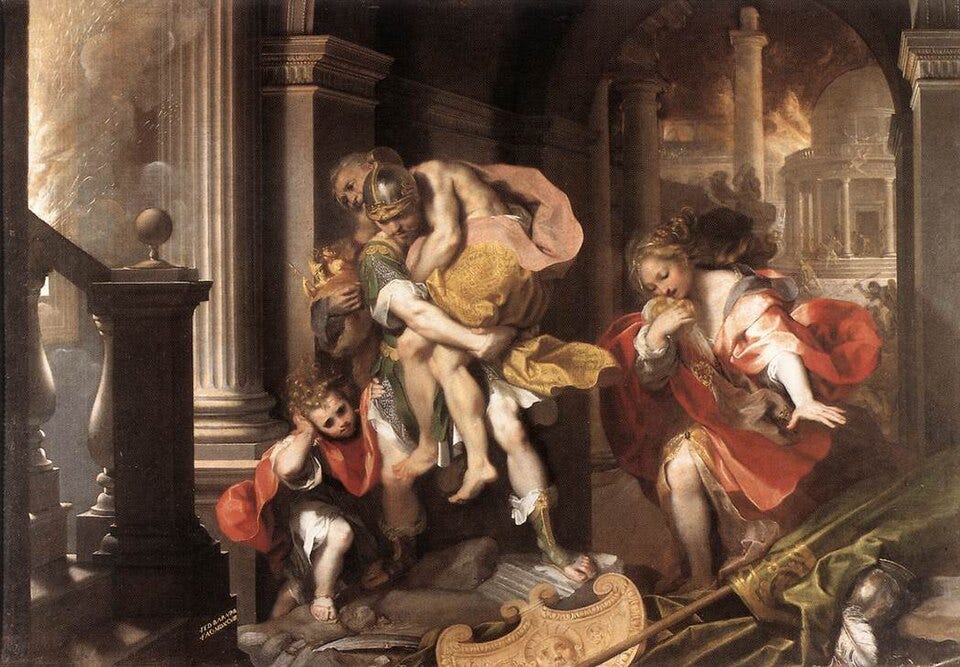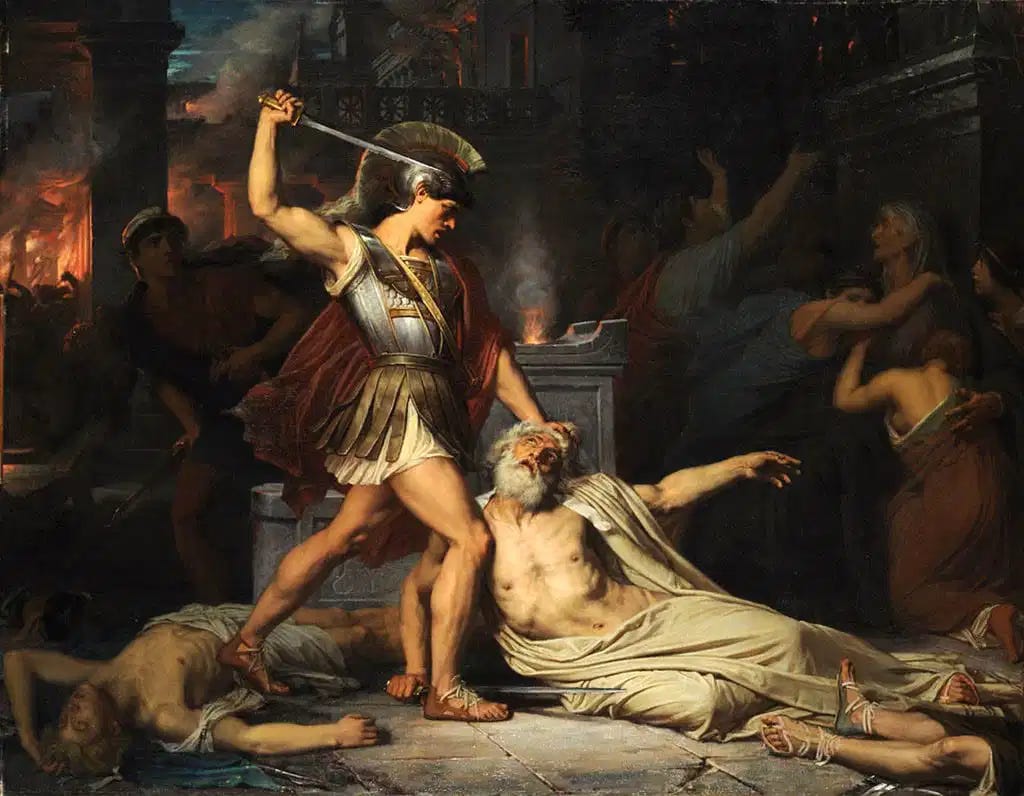There’s no doubt that Homer’s Iliad and Odyssey are foundational texts in Western literature and rightly hold great reverence in the world to this day. They have inspired countless works of art, whole genres of storytelling and even a few terrible modern Hollywood movies. However, they have a forgotten cousin in Virgil’s Aeneid, which has lost ground on Homer’s works in recent times and faded into relative obscurity. Today I make the case for why we should love the Aeneid just as much as its cousins, and appreciate the many unique elements it has to offer.
Note: This article will become available to free subscribers on 1/8/2025
What happened to the Aeneid?
So why has the Aeneid fallen out of favour? For one, its decline in popularity has followed the decline in interest and study of Latin amongst the general population. Learning Latin in school was the gateway to the story and added an additional layer of appreciation. While Homer was studied in Ancient Greek classes, the Odyssey especially has been included in a number of English literature courses, owing to its foundational impact on the genre. Not having such a pre-eminent claim, the Aeneid is rarely taught outside of a Classics context.
Why do some dismiss the Aeneid?
Some of the common criticisms you hear of the Aeneid are that the work is boring, derivative, or purely Roman propaganda. While on the surface these might seem like sound points to make, they belie a lack of understanding and engagement with the work that would challenge these beliefs. Firstly, the accusation that it is boring is one that has some merit if the work is compared alongside a modern novel. But just as with the Iliad and the Odyssey, the story preceded the concept of a novel by many centuries and can be consumed in many different ways. There are parts of each of these epics that are not as exciting as others, and honestly - you don’t have to read them! The beauty of the Aeneid is that you can pick a chapter and start reading and you don’t have to worry a huge amount about what came before.
The second point often made is that the work is derivative, a lowly copy or ‘fanfic’ of Homer’s own works. The latter term is often used jokingly of the story, as it generally follows the rough course of the Odyssey in the first half and the Iliad in the second. However, to dismiss the work as being a copy or a rip-off without value fails to properly appreciate how authors in the ancient world approached their existing canon. It’s fair to say there were a lot fewer stories back then than there are today, so models for literature were limited. Furthermore, it was seen as a sign of great respect to reference, mirror and improve a previous work. The Aeneid is an example of the Roman term aemulatio, where Virgil was deliberately choosing to draw upon many previous works, especially but not limited to Homer, and through his own practice create something even better. He did so knowing full well that future authors would attempt to do the same with his work, as Dante did in some ways in the 14th Century. When you sit down to read the work with this knowledge, you will start to see how lovingly crafted it is.
The final and most controversial criticism of the Aeneid is that it was a product of Roman propaganda during the early days of the Principate under Augustus. Readers will point to several key moments in the story where Virgil directly references Augustus and praises him in a way that modern writers would (mostly) never dare for politicians. While these passages certainly exist within the work, it’s worth noting that they are mostly self-contained and do not overly affect the narrative. Once again, understanding the context of the work helps explain these perhaps incongruous moments. Virgil was elevated to his high status in Rome by the patronage of Maecenas, who collected talented authors and funded their works. Maecenas in turn was Augustus’ client, and by extension so were all of Maecenas’ clients. This didn’t mean that they were contractually obliged or censored, but it did mean that they were expected to pay homage to their patrons in their works. If you read a collection of Horace’s Odes, you’ll find one praising Maecenas and another praising Augustus. It was just the done thing - and Roman audiences would see that for what it was.
Some contend that the larger themes of the work also represent a form of Roman propaganda, pushing a narrative of selfless subservience to the state and promoting the ‘Golden Age’ of Augustus. The Aeneid at its heart is a founding story for Rome, and Virgil did incorporate the mores of his time into the work, doubtless influenced again by his patron. But it’s also worth noting that Augustus wanted a contemporary work praising him and his accomplishments, and Virgil flat out refused to write this. Instead, he layered in some of the ideas that Augustus would have wanted to see to appease him, which seemed to meet his approval. More interestingly, however, is the idea that there exists a more subtle criticism of Augustus throughout the work, and that its ending especially leaves the audience perhaps questioning the glory and achievements of Rome and asking, what was the cost? So you see, it’s only through actually engaging with the work that we can begin to see its true value. Don’t write it off!
Why should you read the Aeneid?
Enough about reasons not to read the work, let’s get into all the reasons why you should! As the work is roughly the same length as each of Homer’s, there is equally a huge depth of great moments, characters and themes to explore. The one advantage that Virgil had over Homer (let’s treat him as though he were a single person) is that he had a lot of time to carefully craft his work and interweave all his references and ideas throughout. Whereas the Iliad and the Odyssey were the product of the oral tradition, the Aeneid is certainly a work of literature - it was written down from the beginning. But because the tropes and techniques of the oral tradition were so familiar by his time, Virgil was also able to include them in his work and improve upon them. Each reference, each simile, each allusion is carefully chosen and painstakingly polished - so much so that a few lines were still unfinished when he fell ill and he demanded that the work be destroyed! Luckily for us, Augustus made sure it was preserved and published. So let’s look at some of the main reasons I think you should give the work a go:
Complex Characters
Virgil is a master at creating three-dimensional characters who face difficult decisions and experience great highs and equal lows. From the outset, Aeneas is a character that many find hard to understand; he is the son of a Goddess and a prince of Troy, but he also makes some rather bad decisions. However, his struggle and development is ultimately extremely rich in the drama of the human condition. Aeneas is, at his core, a man and his reactions to experiences are more relatable. As Virgil tells us in his opening invocation, Aeneas is driven by fate, a prophecy that he will find Italy and found a race there that will go on to become the Romans. But Aeneas, who has just seen his home and his people destroyed, doesn’t know where Italy is or why he has to go there. He just wants to get his life back on track. Over the story he learns more about his destiny and is shaped by forces around him, but the final conclusion (no spoilers) to the tale cements the fact that he is so very human.
Alongside Aeneas, likely the most famous character is Queen Dido of Carthage, one of the great tragic figures in all of literature. Book 4 of the Aeneid stands alone as an immense work of tragedy, which is rarely featured in epic poetry, and she takes centre stage throughout. It’s not often when you upstage the guy the book is named after! Dido is another extremely human character, sabotaged by divine powers beyond her control, overpowered by base emotions and cruelly driven to a fiery, fatal climax. Virgil presents such an intense portrait of Dido, with such care and panache, that you start to wonder if Aeneas is really the bad guy! While her story is tragic, it is certainly an improvement on the somewhat unseen female characters of Homer’s work, with Penelope perhaps the only exception.
Alongside these mortals are the meddling gods, Juno and Venus in particular. Juno is the main, unseen antagonist of Aeneas’ quest, and her rage knows no bounds - except the designs of fate. And yet despite the unimpeachable word of Jupiter that she cannot change that course of fate, she is determined to make the journey to that settled end as bitter and painful for Aeneas as possible. She is certainly a step up from the antagonism of Poseidon in the Odyssey and is nicely balanced out by Venus. As his mother, Venus naturally tries to help and guide Aeneas, but she is just as fallible in doing this as any mortal. Much of her meddling turns out for the worst, and so we see again the human element in the gods.
Finally there is a whole host of other characters, from local Italian mythical figures written into lore, to bold adversaries to rival Aeneas’ prowess in battle. Virgil makes the most of a somewhat clean slate to craft his own unique cast while also drawing sympathetically on the familiar ones from other works.
Thrilling scenes and story arcs
The Iliad and the Odyssey have some incredible scenes, like the duel between Hector and Achilles, Odysseus and the Cyclops, and many more. The Aeneid has no shortage of memorable moments too, which make for a ripping read. One of the best parts about the story’s close link to the events of Homer’s stories is that it can fill in some of the gaps not included - particularly, the Wooden Horse and the fall of Troy. Through a flashback narrated by Aeneas, we get the whole tale of the horse, the sack and the escape in a nice narrative order, something many people find missing in Homer’s tales. Furthermore, Virgil gives us an incredibly unique perspective by telling these through the eyes of Aeneas, giving us the Trojan perspective on the massacre, which was otherwise underdeveloped up to this point. It makes all the great moments much more poignant, as Aeneas tells us how close they were to discovering the trap and saving themselves - but no, the gods once again stepped in to make sure of it.
Another breath-taking development is Aeneas’ katabasis, his descent into the Underworld. While Odysseus does visit some of the spirits in the underworld, Virgil goes one better and takes his hero on a full tour of the realm. He meets Cerberus, Charon, the spirits of friends and enemies, and most importantly his dearly departed father. It’s also one of those moments when Virgil slips in his ultra-patriotic, ‘wow isn’t Rome great’ bits, but even then he fills it with human emotion. Aeneas sees the ghosts of future Romans, souls yet to be born, and among them is Marcellus, the nephew of Augustus, who had died not long before the piece was written. Virgil gives a stirring tribute to the beloved young man, so moving that it is said his mother, Octavia, fainted from grief upon hearing it. The whole journey is quite compelling and played a part in inspiring Dante’s Inferno.
Some smaller stories are equally beautiful, such as the tragic story of Nisus and Euryalus, where both the incredible highs and lows of human emotion meet. There are great storms, formidable monsters, athletic contests, immense battles and more to be discovered in every corner of the tale. The ending, too, is one that leaves us desperate for more, which can’t be a bad thing!
Beauty of Language
One of the greatest things about learning Latin is it unlocks your appreciation of these stories on new levels, which cannot be replicated when reading in translation. The Aeneid, as with Homer’s works in the original Greek, is full of linguistic devices that don’t (easily) survive the effort to put them into language. Virgil paints scenes with sounds from consonants, vowels and the placement and arrangement of lines adds unique dimensions we cannot see. Most of all, the meter of the poetry gives a breath of fresh air to the narrative, where a fast line can signal the approach of cavalry or a slow one can threaten looming danger. Despite these losses, the language of the poetry is still beautifully rendered in many of the great translations we have. We can still admire his incredible extended similes, digressions and ekphrasis, and many English versions bring their own special tone in the prose. Some have even attempted it in rhyming verse (though in my opinion it sounds a bit dated now). All of which is to say, pick up the book, have a read and find out for yourself!
So, have I convinced you yet? Let me know your thoughts, if you’ve read it or want to, or don’t really care! I’d love to hear from you. See you next time!






